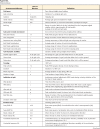Objective Gait and Balance Impairments Relate to Balance Confidence and Perceived Mobility in People With Parkinson Disease
- PMID: 27149959
- PMCID: PMC5088223
- DOI: 10.2522/ptj.20150662
Objective Gait and Balance Impairments Relate to Balance Confidence and Perceived Mobility in People With Parkinson Disease
Abstract
Background: Body-worn, inertial sensors can provide many objective measures of balance and gait. However, the objective measures that best reflect patient perception of mobility disability and clinician assessment of Parkinson disease (PD) are unknown.
Objective: The purposes of this study were: (1) to determine which objective measures of balance and gait are most related to patient perception of mobility disability and disease severity in people with PD and (2) to examine the effect of levodopa therapy on these correlates.
Design: This was an experimental correlation study.
Methods: One hundred four people with idiopathic PD performed 3 trials of the Instrumented Stand and Walk Test (ISAW) in the "on" and "off" medication states. The ISAW consists of quiet standing (30 seconds), gait initiation, straight walking (7 m), and turning (180°), yielding 34 objective measures of mobility from body-worn inertial sensors. Patient perception of mobility disability was assessed with the Activities-specific Balance Confidence (ABC) scale and the mobility subscale of the Parkinson's Disease Questionnaire (PDQ-39). Disease severity was assessed with the Unified Parkinson's Disease Rating Scale, part III (motor UPDRS). Spearman correlations were used to relate objective measures of mobility to patient perception and disease severity.
Results: Turning speed, gait speed, and stride length were most highly correlated to severity of disease and patient perception of mobility disability. The objective measures of mobility in the off-medication state were more indicative of patient perception of mobility disability and balance confidence compared with on-medication state measures.
Limitations: Causation is an inherent problem of correlation studies.
Conclusion: Physical therapists should evaluate mobility in people with PD in the off-medication state because the off-medication state is more related to disease severity and patient perception of mobility disability than the on-medication state mobility. Assessment and treatment of mobility in people with PD should target specific measures (ie, turning, gait speed, and stride length) because these measures best reflect patients' quality of life and balance confidence.
© 2016 American Physical Therapy Association.
Figures





References
-
- Adkin AL, Frank JS, Jog MS. Fear of falling and postural control in Parkinson's disease. Mov Disord. 2003;18:496–502. - PubMed
MeSH terms
Substances
Grants and funding
LinkOut - more resources
Full Text Sources
Other Literature Sources
Medical

